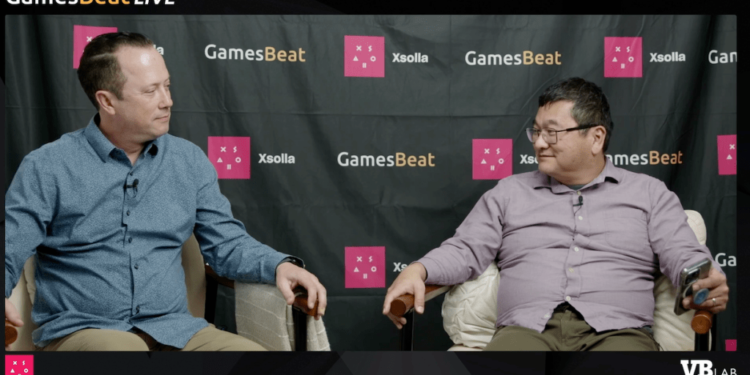The gaming market is dominated by mobile. Its audience spans across demographics, from younger hardcore FPS players with deep pockets to the women gamers flocking to casual games in record numbers. However, monetizing those games has traditionally been a challenge, until now. With recent regulations forcing app stores to release their death grip on the player journey, developers can market and sell directly to their users through social channels and web stores, opening up brand new revenue streams, boosting engagement and bringing players back again and again.
In the latest GamesBeat LIVE, presented by Xsolla and VB Lab, Berkley Egenes, chief marketing and growth officer at Xsolla, joined GamesBeat lead writer Dean Takahashi for a conversation about the future of game monetization in a world where direct to consumer sales have changed the face of mobile game monetization.
“What we’re seeing is when developers get involved actively with their own digital experience and own that branded experience, they’re starting to see growth,” Egenes says. “They’re monetizing in multiple different ways and through different channels. Web shops enable a true ecommerce experience — my skins or my gems or the weapons that I need to go play the game, even though it’s on a mobile device, I still order it online.”
Solving mobile and web measurement challenges
Not all regulations have been great news for mobile developers — privacy regulations have dramatically deprecated access to critical player data, turning accurate ad campaign tracking, and reliable LTV and ROAS measurement across platforms, into major challenges. To address these obstacles, Xsolla recently partnered with AppsFlyer, a mobile measurement, attribution and data analytics company, to develop no-code solutions for cross-platform measurement and web shop attribution.
There are two custom integration options: server-to-server (S2S) and web integrations for mobile games, both of which offer data on user behavior, campaign performance and revenue attribution across mobile and web platforms.
The mobile S2S integration enables complete lifetime value (LTV) and return on advertising spend (ROAS) measurement for purchases made within the application and on the web shop. Web shop purchases are measured as in-app events, and AppsFlyer attributes each purchase to the number of mobile application installations, user acquisition and re-engagement campaigns to help provide a complete cross-platform user journey, complete LTV and overall ROI.
The web integration activation is designed to measure and assess marketing performance, advertising conversion rates, high-performance advertising creatives and re-targeting efforts for web shops using Xsolla’s Site Builder. Developers can measure the effectiveness of ad campaigns driving traffic to their web shops through Xsolla’s and AppsFlyer publisher accounts.
“Before this, you had three or four dashboards,” Egenes said. “Now through our publisher account, AppsFlyer integrates in a matter of minutes and you can see it all in one place, run that campaign, test your ads and own that ecosystem from essentially A to Z.”
Boosting LTV and retention with loyalty as a service
“In one of our recent reports, 77% of people who knew about the web shop made a purchase,” Egenes said. “Looking at it from a UA perspective, that’s incredible — over three quarters of users, and then 90% of those people are coming back. And you’re seeing fifty-dollar, hundred-dollar transactions.”
Loyalty programs are a powerful way to capture the enthusiasm of those players, by rewarding them for their time and financial investment. Bonuses, discounts and special offers to regular customers encourage repeat purchases and sustained engagement, and meaningful incentives for engagement foster a loyal community. Loyalty programs can even convert free-to-play users into paying customers with targeted exclusive and limited time offers, and attract players to other publisher titles. Plus, the data collected from loyalty programs offers a deeper level of insight into player behaviors.
Xsolla recently introduced a loyalty-as-a-service (LaaS) solution that seamlessly integrates ready-made, customizable reward systems to encourage player engagement and spending, without the need for extensive backend development. Unlike third-party rewards platforms, players earn and redeem points for in-game purchases, exclusive content or discounts, all while staying within the developer’s ecosystem, so developers maintain full ownership of their player relationships.
The solution is built to be flexible and easy to implement across multiple touchpoints, including direct-to-consumer stores, web shops and at checkout within existing Xsolla solutions, so that earning and redeeming points is frictionless. Branding and loyalty mechanics are fully customizable, and programs can be activated directly within Xsolla Pay Station with just one click. Developers can offer cashback rewards, loyalty points for exclusive items, flexible redemption options, cross-title loyalty programs and tier-based rewards.
The future of mobile monetization
For developers looking for new ways to optimize their monetization strategy, Egenes said don’t be afraid to leap right in.
“Don’t be afraid — try, test, make some mistakes, learn lessons of what’s going on and what works,” he said. “Use advertising, use social media, use influencers, leverage the content creators. Even an extra 10% is real money to your business. That can go into UA, retention, loyalty or put it in your next game.”
The post Direct-to-consumer is redefining mobile game monetization appeared first on Venture Beat.


















